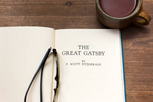 The Great Gatsby by F. Scott Fitzgerald is more than just a story about love and loss; it’s a beautiful fabric with colors that stand for things. Fitzgerald is a master at using color to show what the characters want, what they dream about, and how empty their fancy lives are.
The Great Gatsby by F. Scott Fitzgerald is more than just a story about love and loss; it’s a beautiful fabric with colors that stand for things. Fitzgerald is a master at using color to show what the characters want, what they dream about, and how empty their fancy lives are.
Green: The Far-Fetched Hope
Green is the main character and stands for Gatsby’s desire for Daisy Buchanan and, by extension, the American Dream. That green light at the end of Daisy’s dock is Gatsby’s unwavering hope that he will one day be able to reach her. It serves as a warning that Gatsby’s wish to relive the past is a false hope.
Yellow: Glory Stained
Yellow is linked to both wealth and excess, as well as decay and bad morals. Gatsby’s flashy yellow Rolls-Royce comes to represent his stolen wealth and the meaninglessness of his materialistic life. The Valley of Ashes, a barren area covered in a yellowish haze, shows how morally bad things were in the 1920s.
White: I Lost My Childhood
White plays Daisy Buchanan, who stands for youth and purity. Daisy’s white dress, on the other hand, is just a mask for how shallow and careless she really is. Throughout the story, the white becomes dirty, which represents how Gatsby’s dream and the American Dream become tainted.
Final Thoughts
Fitzgerald’s choice of colors isn’t just for looks. We can learn more about the people and themes of the book with this powerful tool. By using these symbolic colors, he shows us the emptiness that lies beneath the glitz of the Jazz Age. This makes us feel a deep desire and loss.
